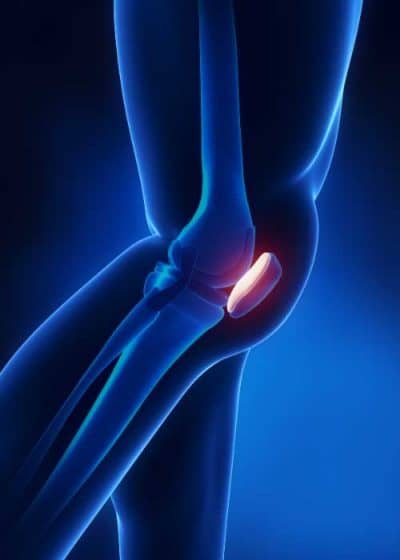Complex Knee Surgeon

Are you experiencing chronic knee pain and difficulty kneeling, climbing stairs, or squatting? If so, you may have patellofemoral osteoarthritis, a condition where the cartilage in your knee wears down resulting in painful movements of the knee. This condition is often treated with patellofemoral arthroplasty. Complex knee surgeon, Dr. Matthew Provencher, provides diagnosis and treatment for patients in Vail, Aspen, Colorado Springs, and the Denver, Colorado area experiencing chronic knee pain. Contact Dr. Provencher’s team today!
What is patellofemoral osteoarthritis?
The knee joint is formed by the articulation of the distal femur (thigh bone), proximal tibia (shin bone), and the patella (kneecap), and can be separated into three different compartments: medial (towards the midline), lateral (away from the midline), and patellofemoral. The patellofemoral compartment relates to the anterior (front) section of the knee joint involving the patella and femur. The patella is seated in the trochlear groove, a bony channel on the distal femur; and, similar to a train on a track, the patella travels along this groove with knee flexion and extension. The bones of the knee joint, including the underside of the patella, are enveloped in a white, slippery connective tissue, known as articular cartilage, that reduces friction and allows the bones to painlessly glide over one another with joint movement. Osteoarthritis is the result of this cartilage deteriorating or becoming damaged causing bone-on-bone movement. This condition can affect all three knee compartments or be confined to one singular area, known as unicompartmental.
What is the treatment for patellofemoral osteoarthritis?
Individuals with mild to moderate anterior knee pain as a result of patellofemoral osteoarthritis may benefit from conservative therapies alone. A combination of rest, alternating ice and heat application, and non-steroidal anti-inflammatory medications (NSAIDs) can control the pain and inflammation associated with this condition. If pain and inflammation continue to persist, a corticosteroid injection can be administered directly into the patellofemoral compartment. A physical rehabilitation program is also encouraged when appropriate.
When normal daily activities become affected by chronic and severe anterior knee pain, or if conservative therapy is unsuccessful, surgical intervention may be necessary to restore knee function. Traditionally, a total knee replacement was the standard of care in which a metal and plastic prosthesis replaced all three knee compartments. Technological advancements in orthopedic surgery, however, have culminated in the design of a partial knee replacement for individuals with advanced osteoarthritis limited to one compartment. Patellofemoral arthroplasty is a less invasive procedure that uses metal and plastic implants to resurface the underside of the patella and the trochlear groove. Dr. Matthew T. Provencher, orthopedic knee doctor, treats patients in Vail, Aspen, Colorado Springs, and the Denver, Colorado area who have experienced patellofemoral osteoarthritis and are in need of patellofemoral arthroplasty.
What are the advantages of a patellofemoral arthroplasty?
Dr. Provencher will evaluate several factors, such as the patient’s age, medical history, and desired outcome, to determine if a patellofemoral arthroplasty is an appropriate treatment option. A patellofemoral arthroplasty offers a faster recovery due to the smaller incisions and less surgical trauma utilized in this procedure. Because more of the natural tissue is retained in a patellofemoral arthroplasty, patients report greater overall knee function that feels more natural over a traditional total knee replacement.
How is a patellofemoral arthroplasty performed?
Although a patellofemoral arthroplasty is less invasive than a total knee replacement, an overnight hospital stay is still required. A nerve block is administered prior to starting and the patient is situated into the appropriate position. Dr. Provencher may perform an examination under anesthesia prior to the procedure to verify ligament integrity throughout all three knee compartments. An incision is then made along the anterior knee exposing the patellofemoral compartment. Methodical examination of the entire knee joint is also performed to confirm unicompartmental damage. A patellofemoral arthroplasty is then completed with the following two-step process:
- Bone Preparation. Any tissue damage on the underside of the patella and the trochlear groove are excised and removed using specialized surgical instruments. Small bone fragments are also removed to prepare for the prosthetic implants.
- Implant Positioning. The trochlear groove is resurfaced using a thin metal component and a high-density patellar “button” resurfaces the underside of the patella. Both of these prosthetic implants are secured in place with bone cement.
What is the recovery period like after a patellofemoral arthroplasty?
After a successful patellofemoral arthroplasty, patients in the Vail, Aspen, Colorado Springs, and the Denver, Colorado area can expect a return to normal daily activities in approximately 6 to 12 months. Patients can also typically expect the following:
- Weight-bearing will begin immediately after surgery with the assistance of a cane, crutches, or walker.
- Pain and inflammation can be controlled with a combination of rest, ice, and non-steroidal anti-inflammatory medications (NSAIDs).
- The key to a successful recovery following patellofemoral arthroplasty is the active participation and completion of the physical rehabilitation program set forth by Dr. Provencher. The physical therapy program will focus on strengthening the quadriceps muscles and preserving knee range of motion. Muscle strength restoration is the primary determinant for a full recovery.
For more information on patellofemoral arthroplasty, or to discuss your patellofemoral osteoarthritis treatment options, please contact the office of Matthew T. Provencher, MD, orthopedic knee doctor at The Steadman Clinic, serving Vail, Aspen, Colorado Springs, and the Denver, Colorado area.
